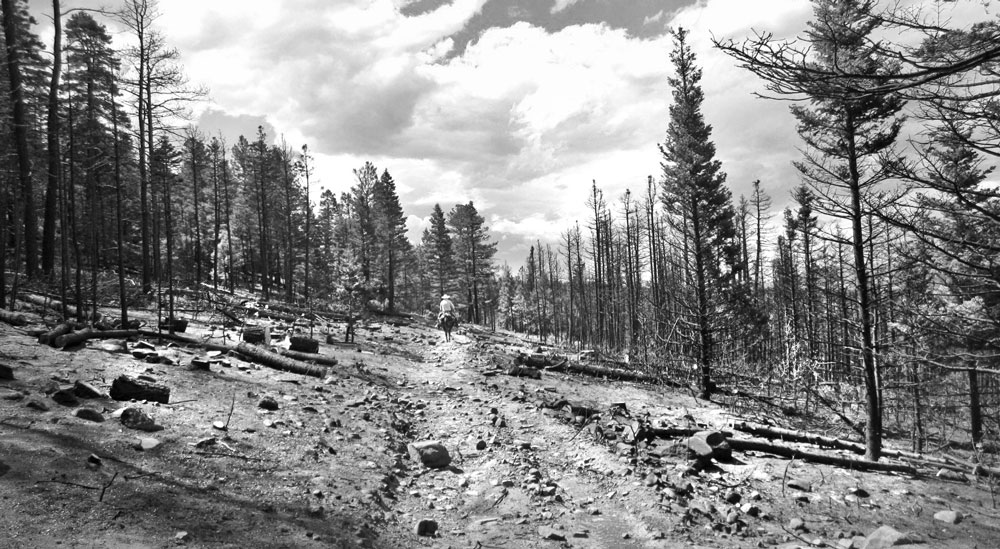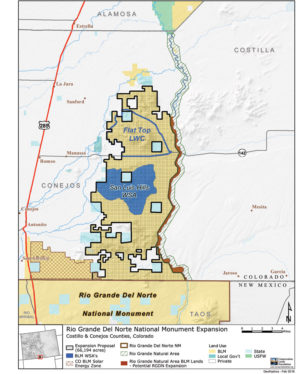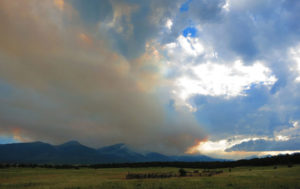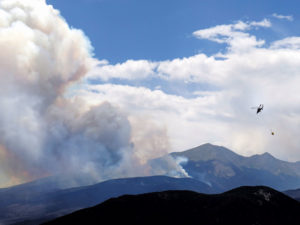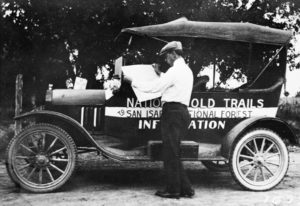
By Ron Sering
The journal Science reports that fossil records in northern New Mexico show evidence of wildfires as far back as 200 million years. It’s part of the deal with living in the mountains, and an important part of its history.
The Chaffee County region has had its share of past fires. The July 12, 1901, Salida Record reported that, a “Great forest fire has been raging for several days beyond Shavano mountain and has already destroyed an immense amount of timber that is so precious in this country. The origin of the fire is not known, but is likely the same old cause – carelessness …”
The area above Poncha Springs appeared to be a real trouble spot, because the Record reported in May of 1902 that “The forest fire that has been raging on the foothills of Shavano for the past month or more seems to have almost burned itself out.”
The Record article continued, “if the parties who are responsible for the starting of the fires are found, they will find a warm reception at the hands of an indignant and outraged public.” Responsibility for the fire was eventually laid on a man named Finlay, who apparently tried to dispose of the carcass of a cow by setting fire to it. His eventual fate is unknown.
The fires persisted, however, into June. The June 24, 1902, Salida Mail reported, “Fires have been burning to the west and north-west in the heavy timber on the sides of Shavano, Ouray and Ghipeta (sic) for the last month and more and have done damage beyond computation.” The blaze threatened the mining town of Garfield until the winds shifted and the town was spared. The air in the region “was thick and stifling, and the whole sky was obscured by the burning.”
Elsewhere that year, a fire estimated at 3,000 acres burned in Dillon and another in Estes Park drew the attention of government timber inspectors to “give a few random instructions and depart.”
Things seemed to calm down for a time, until the Akron (Colorado) Weekly Pioneer Press reported in 1912 to a “forest fire raging on Mount Harvard, eight miles west of Buena Vista.”
The Big Burn and the Aftermath
The 1901 and 1902 fires in the Chaffee County region were part of a general increase in western wildfires in the early part of the century, culminating in the Big Burn of 1910, which consumed nearly three million acres in the northern Rockies and killed 87 people, including 78 firefighters. Subsequent heads of the National Forest Service, founded as an individual entity in 1905, each fought in the Big Burn, and their experience affected wildfire policy for many years to come.
The focus was on prevention and suppression. With an expansion in the firefighting force in the 1930s manned by members of the Civilian Conservation Corps, along with improved technology and expanded resources, the NFS observed a “10 a.m. policy,” that fires should be extinguished by 10 a.m. the next day. It worked; the Big Burn remains the nation’s largest wildfire.
[InContentAdTwo]
Modern Times
By the 2000s, wildfires statewide were on the increase. With the pine beetle infestation, many forests were in declining health, and in the drought year of 2002, the snowpack in the Arkansas basin stood at 23 percent of the historical median, and was fully melted out by Memorial Day. Whether by coincidence or not, it was also the worst fire season in Colorado history for acres burned. Soon the Hayman fire near Colorado Springs would erupt, becoming the largest fire in the state’s history.
But a few days before Hayman, sparked by an abandoned charcoal grill, the Iron Mountain Fire, fifteen miles southeast of Cañon City, consumed 4,440 acres, and destroyed more than 200 structures, with no loss of life and three injuries. Losses totaled $7.5 million. No one responsible was ever identified. Iron Mountain was one of 17 fires exceeding 1,000 acres in 2002.
In May of 2008 the Ferguson Fire, believed to have started by a controlled burn that got out of hand, broke out in the heavily wooded Copper Gulch area in Fremont County, but was quickly contained. The blaze burned 190 acres.
In 2011, the Duckett Fire, believed to be sparked by an unattended campfire, burned 4,700 acres a few miles from the small community of Hillside. It started on June 12 and was contained on June 22. The firefighting effort deployed nearly 650 firefighters, four helicopters, one plane and six bulldozers. Firefighting costs were estimated at $5.2 million. The Rainbow Lutheran Camp was evacuated but did not burn. The firebreaks built for that fire are now expected to provide a barrier to the current Hayden Pass Fire.
Both the 2012 and 2013 seasons saw serious fires in the Colorado Springs region. The 2012 Waldo Canyon Fire, ranked as the most destructive fire in state history, burned 18,247 acres, with losses totaling $453 million. The area burn scar continues to be at risk for flash flooding.
On June 11, 2013, the same day as the Black Forest Fire, the 4,000-acre Royal Gorge Fire began south of the Royal Gorge Park, jumped the gorge, and destroyed or seriously damaged 48 of the park’s 52 structures. The bridge received only minor damage, and the park was closed for 14 months. No homes or lives were lost. The fire was determined to be man-made, but no one was ever identified. The Black Forest Fire incurred $420 million in insured losses.
The suppression policies of the early 20th century spared the area of large wildfires, but in the process left an abundance of fuel which, aggravated by warm and dry conditions, has increased the risk and frequency of wildfires. Offense has turned to defense, with a greater emphasis on mitigation and protection of structures. As of now, the Hayden Pass fire, sparked by lightning, stands at 16,000 acres. The only structure lost so far is a small hunting cabin, and no fatalities. The Lutheran Camp has once again been evacuated and is expected to weather this latest round of fires, as is the nearby Cutty’s Resort on Hayden Creek.
Ron Sering lives on a mesa above Howard, and hears helicopters all day long.

